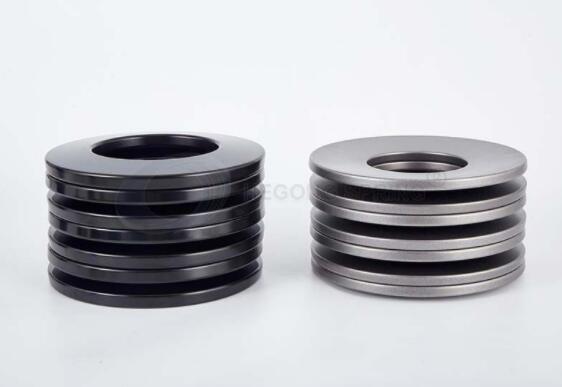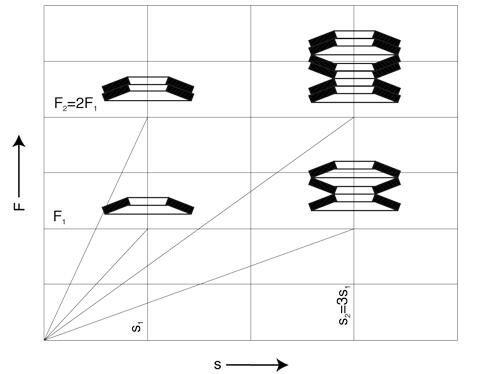The potential combinations of disc springs depend on function and desired force.
Having springs working in tandem is always a challenge, but not when it comes to disc springs.
This type of spring is designed to work together, and the potential combinations for disc springs depend entirely upon the project.
It is extremely important to ensure accuracy in stacking the disc springs. You can do it using either the inside diameter or the outside diameter.
When you stack disc springs, the spring constant, force and travel are changed, depending on the combination.

Single disc springs are assembled ‘opposed to each other’ to form a spring column. This ‘in series’ formation (no.3 in above illustration) is a means of multiplying the deflection of a single disc spring, the force element remains as that for a single spring.
E.G. A disc spring that requires a force of 5000N to deflect 1mm, when assembled to form a column of 10 disc springs in series, will require a force of 5000N to deflect 10mm.
The cumulative effect of bearing point friction of large numbers of disc springs stacked in series, can result in the disc springs at each end of the stack deflecting more than those in the centre. In extreme cases this may result in over-compression and premature failure of the end springs. A ‘rule of thumb’ is that the length of the stacked disc springs should not exceed a length approximately equal to 3 times the outside diameter of the disc spring.
Normally, disc springs stacked in ‘series’ formation are of identical dimensions, however, it is feasible to stack numbers of disc springs of increasing thickness in order to achieve ‘stepped’ and progressive characteristics. With such arrangements, it is necessary to provide some form of compression limiting device for the ‘lighter’ disc springs, to avoid over-compression whilst the ‘heavier’ springs are still in process of deflection.

Disc springs are assembled ‘nested’ inside each other, i.e. the same way up, the resultant force for such a column is the force element of a single disc spring multiplied by the number of ‘nested’ disc springs in the column, whilst the deflection remains the same as for that applicable to a single disc spring.
(See no. 2 above illustration) It must be realised that the individual disc springs in a column assembled in parallel perform as separate entities, thus generating considerable interface friction. For a given deflection, this interface friction will result in 3% increased force per interface, this must be taken into account when calculating the total force from parallel stacking.
E.G. A disc spring that requires a force of 5000N to deflect 1mm, when assembled of 3 disc springs in parallel, will require a force of 15900N to deflect 1mm.
It is advised that the number of disc springs in parallel should not normally exceed 3, or in extreme cases 5 springs, to minimise heat generated by friction or, in the case of static applications, to ensure a workable relationship between the loading and unloading characteristics. The hysteresis resulting from parallel stacking can be employed to advantage in those applications of a ‘shock absorbing’ nature, requiring a damping feature.
The life of disc springs in parallel arrangements is very dependant on adequate lubrication of the spring interfaces.
The combination of both series and parallel stacking (See no. 4 above illustration) is a means of multiplying both force and deflection. The guidelines applicable to this type of arrangement are basically those already outlined, but it cannot be over-emphasised that it is important, at the disc spring selection stage, to minimise the number of springs in the stack by way of examining the various alternatives.
E.G. A disc spring that requires a force of 5000N to deflect 1mm, when assembled to form a column consisting of 3 disc springs in parallel, and 10 units of 3 parallel discs in series – (total 30 discs), will result in a force requirement of 15900N to deflect the stack 10mm – (incorporating an allowance of +6% for friction).


In series-parallel stacking, there must never be a difference in the number of disc springs per bundle. If a bundle has 1 disc spring less than the other bundles, this bundle will naturally not have the same strength, and will therefore become deformed and broken before the other bundles.
You can expect a loss of force when you use several disc springs together in parallel stacking due to the friction.
For customized disc spring solutions, trust Hegong, your ISO 9001 and IATF16949 certified partner. With a variety of materials and configurations, we cater to your specific needs. Contact us today to discover how our expertise can enhance your project!
